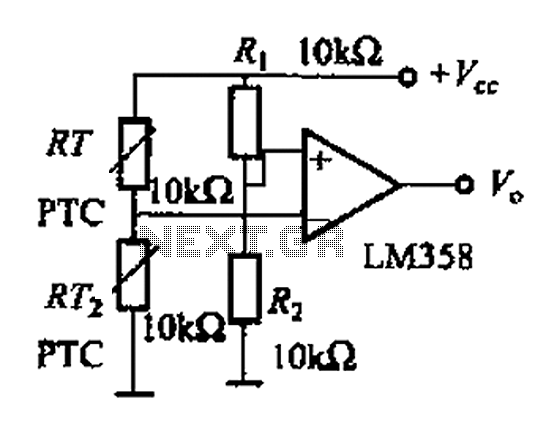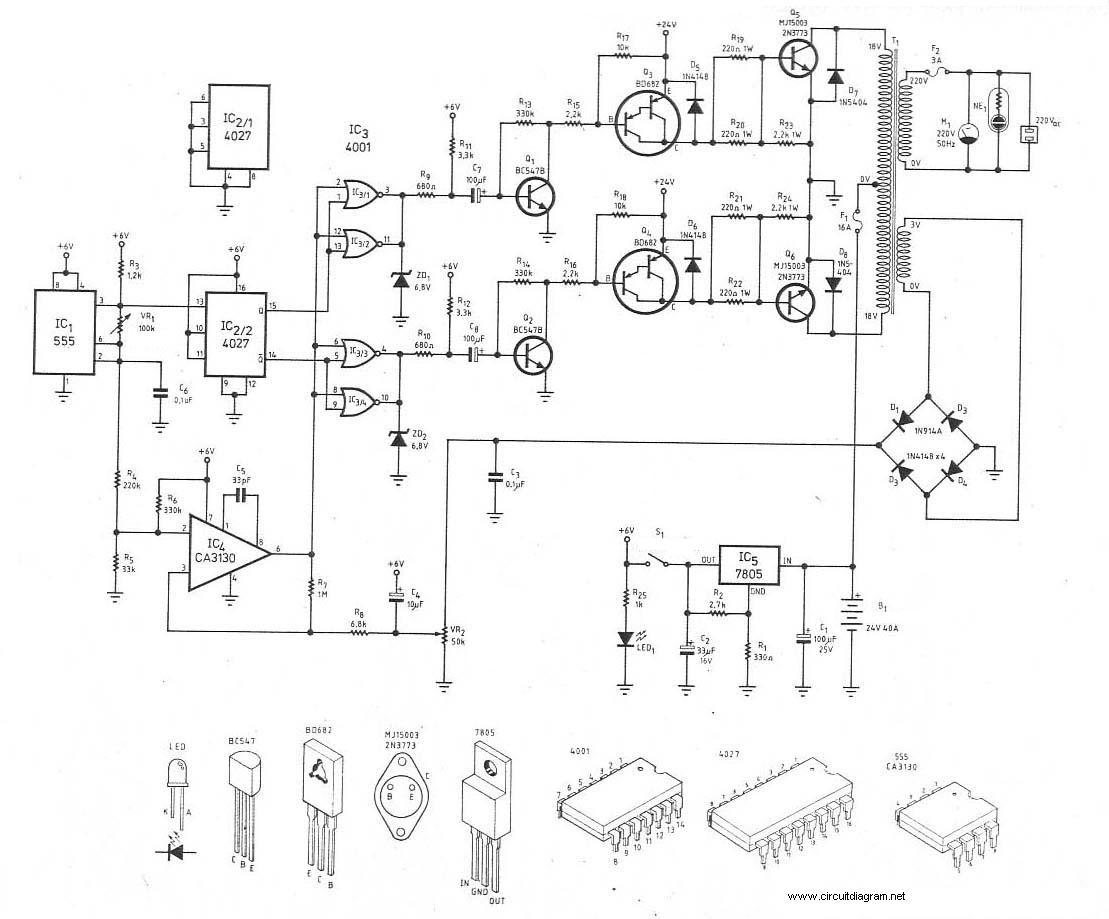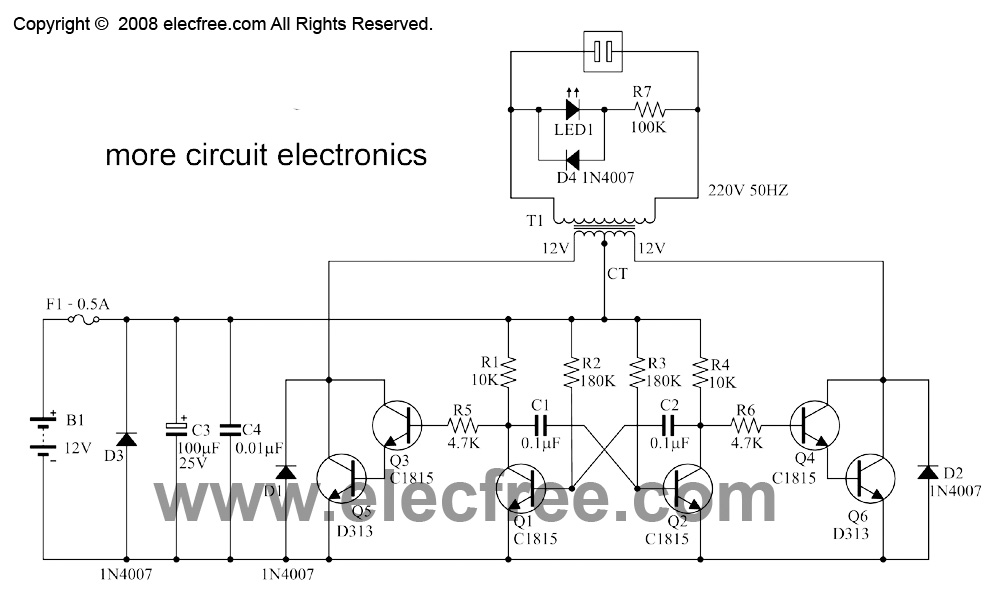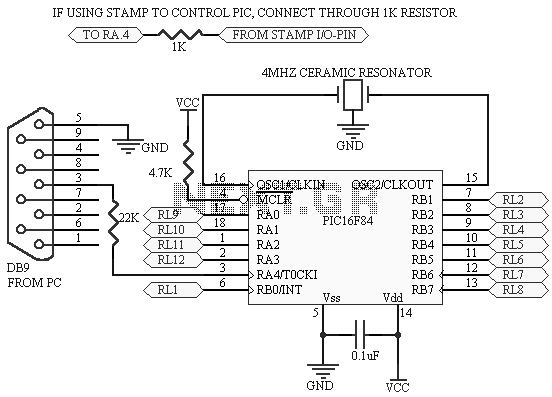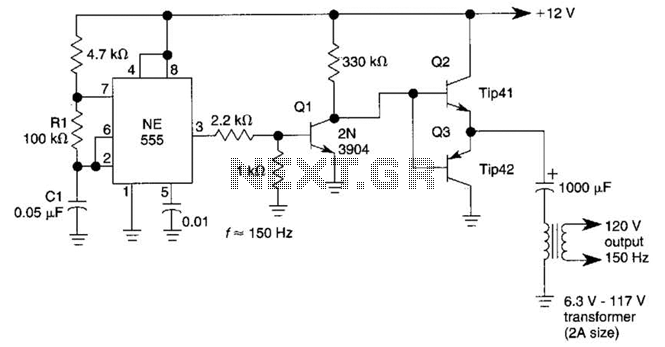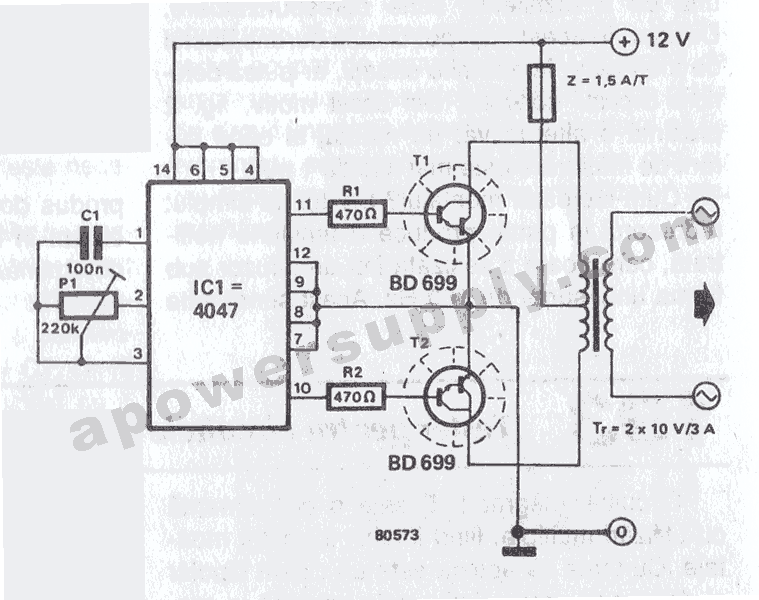
Basic Inverter
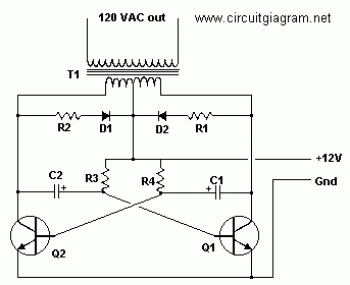
Q1 and Q2, along with T1, determine the wattage output of the inverter. Using Q1 and Q2 as 2N3055 transistors and T1 rated at 15 A, the inverter can provide approximately 300 watts. Substituting larger transformers and more powerful transistors for T1, Q1, and Q2 can yield higher power outputs. One cost-effective method to obtain a larger T1 is to rewind an old microwave transformer, which is typically rated at around 1 kW and is suitable for this application. It is advisable to visit a local TV repair shop and search through discarded items to find the largest microwave transformer available. The size of the microwave correlates with the size of the transformer. Care should be taken when removing the transformer to avoid contact with the large high-voltage capacitor that may still hold a charge. Testing the transformer is optional, as they are generally functional. The existing 2000 V secondary should be removed without damaging the primary winding, which should remain intact. Next, wind 12 turns of wire, creating a center tap loop, followed by an additional 12 turns. The wire gauge should be selected based on the desired current output of the transformer. Enamel-coated magnet wire is recommended for this purpose. Once the windings are completed, secure them with tape. It is crucial to use high-current transistors for Q1 and Q2, as the 2N3055 transistors in the parts list can handle a maximum of 15 amps each. Additionally, tantalum capacitors should be used for C1 and C2, as standard electrolytic capacitors may overheat and fail. The correct capacitance value is 68 µF, with no alternatives. This circuit may be challenging to initiate, as variations in transformers, transistors, and component substitutions not specified in this guide may lead to operational issues.
The inverter circuit described involves a basic configuration where the transistors Q1 and Q2 function as the primary switching elements. The choice of 2N3055 transistors is essential, as they are designed to handle significant current loads, although their limitations necessitate careful consideration of the overall power requirements. The transformer T1 plays a pivotal role in stepping up the voltage from the low-voltage side to the high-voltage output, which is crucial for inverter applications.
When rewinding the microwave transformer, the process of creating a center-tapped secondary winding is critical for achieving balanced voltage outputs. The number of turns in the secondary winding directly influences the output voltage and current characteristics, which must align with the specifications of the load the inverter is intended to drive. The use of enamel-coated magnet wire is advantageous due to its insulation properties, which allow for close winding without short circuits.
The inclusion of tantalum capacitors for C1 and C2 is a vital design consideration, as these components are capable of handling the high ripple currents associated with switching applications without the risk of failure that can occur with standard electrolytics. The specified capacitance value of 68 µF should be adhered to strictly, as deviations could impact the performance and reliability of the inverter.
In addition, the potential variability in component characteristics necessitates a methodical approach to testing and troubleshooting the circuit. Any discrepancies in transformer ratings or transistor parameters can significantly affect the inverter's functionality, thus requiring careful adjustment and possibly iterative testing to achieve the desired performance. Overall, this inverter design represents a practical solution for generating power from a low-voltage source, provided that all components are selected and implemented with precision.Q1 and Q2, as well as T1, determine how much wattage the inverter can supply. With Q1, Q2=2N3055 and T1= 15 A, the inverter can supply about 300 watts. Larger transformers and more powerful transistors can be substituted for T1, Q1 and Q2 for more power. 2. The easiest and least expensive way to get a large T1 is to re-wind an old microwave tran sformer. These transformers are rated at about 1KW and are perfect. Go to a local TV repair shop and dig through the dumpster until you get the largest microwave you can find. The bigger the microwave the bigger transformer. Remove the transformer, being careful not to touch the large high voltage capacitor that might still be charged.
If you want, you can test the transformer, but they are usually still good. Now, remove the old 2000 V secondary, being careful not to damage the primary. Leave the primary in tact. Now, wind on 12 turns of wire, twist a loop (center tap), and wind on 12 more turns. The guage of the wire will depend on how much current you plan to have the transformer supply. Enamel covered magnet wire works great for this. Now secure the windings with tape. Thats all there is to it. Remember to use high current transistors for Q1 and Q2. The 2N3055 ²s in the parts list can only handle 15 amps each. 5. You must use tantalum capacitors for C1 and C2. Regular electrolytics will overheat and explode. And yes, 68uF is the correct value. There are no substitutions. 6. This circuit can be tricky to get going. Differences in transformers, transistors, parts substitutions or anything else not on this page may cause it to not function. 🔗 External reference
The inverter circuit described involves a basic configuration where the transistors Q1 and Q2 function as the primary switching elements. The choice of 2N3055 transistors is essential, as they are designed to handle significant current loads, although their limitations necessitate careful consideration of the overall power requirements. The transformer T1 plays a pivotal role in stepping up the voltage from the low-voltage side to the high-voltage output, which is crucial for inverter applications.
When rewinding the microwave transformer, the process of creating a center-tapped secondary winding is critical for achieving balanced voltage outputs. The number of turns in the secondary winding directly influences the output voltage and current characteristics, which must align with the specifications of the load the inverter is intended to drive. The use of enamel-coated magnet wire is advantageous due to its insulation properties, which allow for close winding without short circuits.
The inclusion of tantalum capacitors for C1 and C2 is a vital design consideration, as these components are capable of handling the high ripple currents associated with switching applications without the risk of failure that can occur with standard electrolytics. The specified capacitance value of 68 µF should be adhered to strictly, as deviations could impact the performance and reliability of the inverter.
In addition, the potential variability in component characteristics necessitates a methodical approach to testing and troubleshooting the circuit. Any discrepancies in transformer ratings or transistor parameters can significantly affect the inverter's functionality, thus requiring careful adjustment and possibly iterative testing to achieve the desired performance. Overall, this inverter design represents a practical solution for generating power from a low-voltage source, provided that all components are selected and implemented with precision.Q1 and Q2, as well as T1, determine how much wattage the inverter can supply. With Q1, Q2=2N3055 and T1= 15 A, the inverter can supply about 300 watts. Larger transformers and more powerful transistors can be substituted for T1, Q1 and Q2 for more power. 2. The easiest and least expensive way to get a large T1 is to re-wind an old microwave tran sformer. These transformers are rated at about 1KW and are perfect. Go to a local TV repair shop and dig through the dumpster until you get the largest microwave you can find. The bigger the microwave the bigger transformer. Remove the transformer, being careful not to touch the large high voltage capacitor that might still be charged.
If you want, you can test the transformer, but they are usually still good. Now, remove the old 2000 V secondary, being careful not to damage the primary. Leave the primary in tact. Now, wind on 12 turns of wire, twist a loop (center tap), and wind on 12 more turns. The guage of the wire will depend on how much current you plan to have the transformer supply. Enamel covered magnet wire works great for this. Now secure the windings with tape. Thats all there is to it. Remember to use high current transistors for Q1 and Q2. The 2N3055 ²s in the parts list can only handle 15 amps each. 5. You must use tantalum capacitors for C1 and C2. Regular electrolytics will overheat and explode. And yes, 68uF is the correct value. There are no substitutions. 6. This circuit can be tricky to get going. Differences in transformers, transistors, parts substitutions or anything else not on this page may cause it to not function. 🔗 External reference
